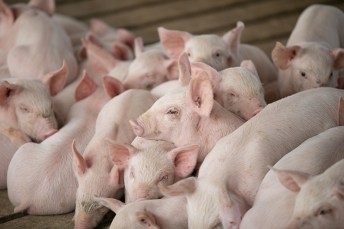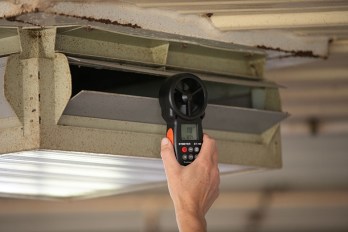In warmer weather, decreased feed intake and slower weight gain in finishing pigs are to be expected. Unlike people, pigs cannot sweat and must cool themselves in other ways, such as panting, making use of air flow, lying on the cold floor or water evaporation from liquid on the skin. Because some of these methods (airflow or evaporation for example) may depend on how facilities are managed, here are some ways to help you prepare your barns and the animals for those warmer months:
General Considerations for Avoiding Heat Stress in Pigs

- Do not underestimate pathogens; remain diligent in biosecurity efforts.
- Double-check refrigerators designed for medication are functioning at the correct temperature whether they are in the office or in the barn.
- When possible, actions such as movements, vaccinating, or sorting should be done during the coolest part of the day.
Pig Barn Ventilation Maintenance
- Ensure all fans are fully operational.
- Check fan belt tension and integrity. Replace as needed.
- Patch any holes in curtains and replace broken or non-functioning louvers.
- Grease curtain and inlet pulleys and controllers.
- Flush all sprinkler and drinker water lines to prepare for regular use during the summer.
- Ensure all drinkers are fully operational and add extra water sources if needed.
- Clean all fans, louvers, cooling pads, and water filters.
- Check the water filter and ensure water quality.
Barn Ventilation + Temperature

- Implement summer ventilation bandwidth.
- 1.5⁰ F for early and inlet/curtain transition stage and 1⁰ F for all other stages.
- If the air coming in from inlets is warmer than the air coming in via curtains, consider closing the inlets and moving to tunnel or cooling pad ventilation.
- In barns with tunnel ventilation, shut side fans off if they are not contributing to ventilation efficiency and wind chill effect.
- Make sure doors stay closed when in tunnel ventilation for maximum efficiency.
- When possible, keep humidity below 65%.
- Air speed at the cooling pad should be 350-400 cubic feet per minute (FPM), 300-400 FPM in the center of the barn, and 650-800 FPM at the curtain when in tunnel mode.
- Water can be an effective cooling method through evaporative heat loss. Sprinklers have been found to be more effective than misters or foggers.
- Visit the Wean to Finish manual for detailed barn temperature goals.
- Check out the Wean to Finish Barn Environment training video here.
Nutrient Availability
- Account for slower growth rates by working with your nutritionist or preparing to keep pigs longer.
- Feed intake will be decreased, reassess diet formulation with your nutritionist.
- Check water availability regularly: both drinking and cooling water.
- PIC recommends a 0.5 liter (L)/minute flow rate for nursery pigs.
- PIC recommends a 1 L/minute flow rate for pigs 60 pounds or more.
- PIC recommends 10-12 pigs per drinker.
- Maintain proper drinker height throughout the summer, height is based on the smallest pig in the pen.
- Nipples at a 90⁰ angle should be at shoulder level.
- Nipples at a 60⁰ angle should be 2-3 inches above shoulder level.
- Bowl lip height should be 40% of shoulder level.
- Wet/dry feeders should have supplementary waters to support pig needs when pigs are greater than 200 pounds and temperatures are above 85⁰ F.
- Water flow rate should be checked in 5-10% of pens on a weekly basis.
- Monitor the water meter daily, any significant changes can indicate a health challenge.
Pig Transport
- Load pigs in the early morning or late evening to help avoid heat stress.
- Provide appropriate ventilation and bedding for the weather conditions.
- Ensure correct group size and handling techniques to minimize stress at loading.
- Avoid having trailers sit in the heat once loaded; the truck should start and keep moving to reduce heat stress.
- Ensure the truck is fueled and has proper documentation; minimize stops on the way to the destination.
- Allow adequate air movement and evaporative cooling for animals on the trailer.
- Consider soaking bedding or pigs right before movement to assist with evaporative cooling. It is essential to start moving immediately after this is done.
- Check truck stocking density and bedding level based on temperature and pig size. Utilize this tool for these calculations.
All of PIC’s recommendations can be easily accessed using our GrowQuest tool. The new Wean-to-Finish training videos also provide an excellent resource for training new employees or as a refresher course for tenured employees. Lastly, the Wean-to-Finish manual is an all-encompassing guide that includes all of PIC’s recommendations.




